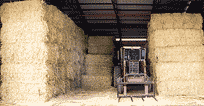|
|
|
|
 |


Top
Stories  |
Bioterrorism
rules trickle down to
hay
| |
|
By
Kristy Hebert
Farm and Dairy
Reporter |
|
 |
 |
 |

|
 |
|
|
 |
 |

|
|
|
Commercial hay
producers may have new traceback regulations on
the horizon, as early as June for larger
operations. (click for larger
version) |
| 04/06/2006 - SALEM, Ohio — Commercial hay
producers soon may be among the growing list of
sectors keeping detailed records and zeroing in
on bioterrorism.
According to the bioterrorism act of 2002, the
federal government says people who transport or
distribute food have only a couple months left
before they must keep detailed
records.
Whether that food is going to
humans or cows doesn't matter; animal and pet
feed is included in the Food and Drug
Administration's definition of
"food."
That's where hay come into
play.
The FDA specifically says farms are
"excluded entirely," but where do commercial hay
producers fit in?
Despite nongovernmental
reports saying they are required to comply, National Hay Association
Executive Director Don Kieffer says no one from
FDA has contacted him or any other national hay
organization about these regulations and
compliance dates.
The FDA did not return
calls from Farm and Dairy to confirm if
commercial hay producers are included in the
definitions.
Should it be true, though,
hay producers need to get moving, and
quick.
 |
 |
 |
| "When I have to
hire another secretary to keep up, I'll take a
hard look at my operation and see whether I
should continue." Larry Brogan owner,
L.J.
Hay | |
 | |
|
For businesses with 11
or more employees, the compliance date is June
9, and it's December for those with fewer than
11 workers.
'It's time.' Other
parts of the industry are going through animal
identification and other record-keeping efforts,
said William Kanitz, president of ScoringAg, a
company specializing in traceback
systems.
"Now it's time for hay
producers," he said.
There are countless
ways someone could introduce a bioterrorism
agent through hay, even when the hauler breaks
at a truck stop, he said.
This is about
protection, Kanitz said. Not only would the
government be able to locate the hay's source
and various stops within minutes, but farmers
would be safeguarded.
Rather than
freezing all shipments to and from a commercial
hay producer and essentially shutting down the
business, the government could home in on a
specific farmer or a certain alfalfa field, he
said.
"If there's a problem, their
records are the only thing between them and the
problem," Kanitz said.
Money and
time. Would that mean identifying each of
the 125,000 small bales and 2,000 large bales
that go through Raymond Bricker's operation each
year?
That's what the producer in Salem,
Ohio, wonders.
It's more than just an
added cost, he said; it's the time it'd take to
put thousands of bar code stickers on all that
hay.
"It all seems far-fetched that this
could be enforced," said Bricker, who is the
past president of National Hay
Association.
Part of the problem, Bricker
and Kieffer agree, is that the only thing hay
producers are hearing about these regulations is
coming from companies who are trying to sell
traceback equipment.
"Until we hear
something official, we're not falling over
backward on this," Kieffer said.
An
end in sight? The regulations require names
and contact information for sources, recipients
and transporters; transportation routes;
transfer points; dates; and details on the
shipments.
They can be kept on paper or
electronically, as long as FDA has access to it
within 24 hours of when it asks.
"Where
does it end?" asked another commercial hay
producer, Larry Brogan of L.J. Hay near
Kensington, Ohio. "There's no end to it. Maybe
they'll be after straw next, or following a
bushel of wheat or bag of oats.
"When I
have to hire another secretary to keep up, I'll
take a hard look at my operation and see whether
I should continue."
(Reporter Kristy
Hebert welcomes feedback by phone at
800-837-3419, ext. 23 or by e-mail at khebert@farmanddairy.com.)
|
 |

|
 | | | |
|
|
.gif)
|